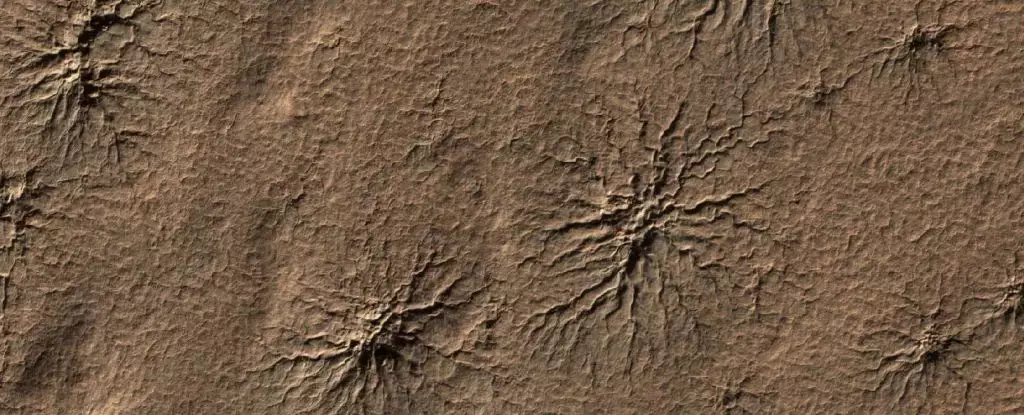Mars, the fourth planet from the sun, is often a subject of intrigue and fascination within the scientific community and the general public alike. Renowned for its reddish hue and barren landscapes, this enigmatic planet reveals more than mere rocks and dust. Among its peculiar features are the enigmatic araneiforms—or what some call “spiders.” These geologic formations cast long shadows across the Martian terrain, attracting the attention of scientists keen on understanding their origins. While they might evoke visions of otherworldly creatures, these formations are far from living entities; they are, in fact, intricate patterns of dust shaped by environmental conditions unique to the Martian surface.
The araneiforms are distinctive to the southern polar region of Mars, making their appearance during the planet’s spring. Their formation remains a source of intense academic inquiry. Researchers, including planetary scientist Lauren McKeown from NASA’s Jet Propulsion Laboratory, have engaged in experimental studies to unravel this mystery. Central to their investigation is the Kieffer model, which posits a fascinating interaction between carbon dioxide and the Martian environment. Unlike Earth, where carbon dioxide exists in liquid form, Mars experiences dramatically cold conditions. Here, carbon dioxide freezes directly into solid ice, a unique characteristic that sets the stage for the emergence of araneiforms.
Behind the Science: The Re-Creation Experiment
To simulate the environment responsible for araneiform formation, McKeown and her team utilized an innovative chamber known as the Dirty Under-vacuum Simulation Testbed for Icy Environments (DUSTIE). This advanced apparatus meticulously emulates Martian atmospheric pressure and temperature, offering a controlled setting where the elusive process can be studied in detail. Within DUSTIE, a simulant crafted to mirror Martian regolith—comprised of minerals mimicking Martian soil—was subjected to liquid nitrogen to replicate the frigid temperatures of Martian winters.
As the experimental setup evolved, carbon dioxide was introduced into the chamber. This gas underwent a chilling transformation, transitioning into solid ice upon contact with the cold simulant. The researchers then gradually warmed the chamber, prompting the carbon dioxide ice to sublime—where it transforms directly from a solid to a gas—creating significant internal pressure. The highly anticipated moment arrived when the built-up gas violently escaped, leaving behind an eruption of dusty debris akin to the distinct spider-like patterns observed in Martian imagery.
A Surprising Revelation
However, as with many scientific expeditions, the results were unexpected. Contrary to the team’s hypothesis, they discovered that the ice had formed beneath the layer of dust, not above it. This crucial finding implies that the massive release of gas was responsible for cracking the layers from within rather than solely scouring the surface, adding a layer of complexity to the understanding of Martian geology. This updated interpretation not only serves to clarify how araneiforms emerge but also suggests that other seasonal Martian phenomena could share similar underlying mechanisms.
The implications of these findings extend beyond the scope of understanding Martian araneiforms. By detailing the precise processes that govern their creation, McKeown’s team sets the groundwork for further explorations into numerous seasonal Martian features. This knowledge holds potential relevance for future missions to Mars, as understanding the geological processes can assist scientists in predicting changes on the Martian surface, fueling ongoing ambitions for exploration and eventual colonization of the planet.
Future Directions and Research
Looking ahead, the scientific community anticipates further experiments aimed at refining these initial results. By manipulating variables in their simulations, McKeown and her colleagues hope to obtain clearer insights into various Martian processes. This research could illuminate not only the formation of araneiforms but also the many geological changes that signify the shifting climates on Mars. Such investigations enhance our understanding of a planet that could someday hold the key to humanity’s future endeavors in space.
As we explore the enigmatic landscape of Mars, features like araneiforms remind us of the planet’s rich geological history and the potential for discovery. The ongoing research by NASA scientists exemplifies the fusion of curiosity and technological innovation, charting a path toward unraveling the mysteries of the universe surrounding us. These Martian “spiders,” while not alive, offer us a gateway to understanding both the past and future of our celestial neighbor.



Leave a Reply